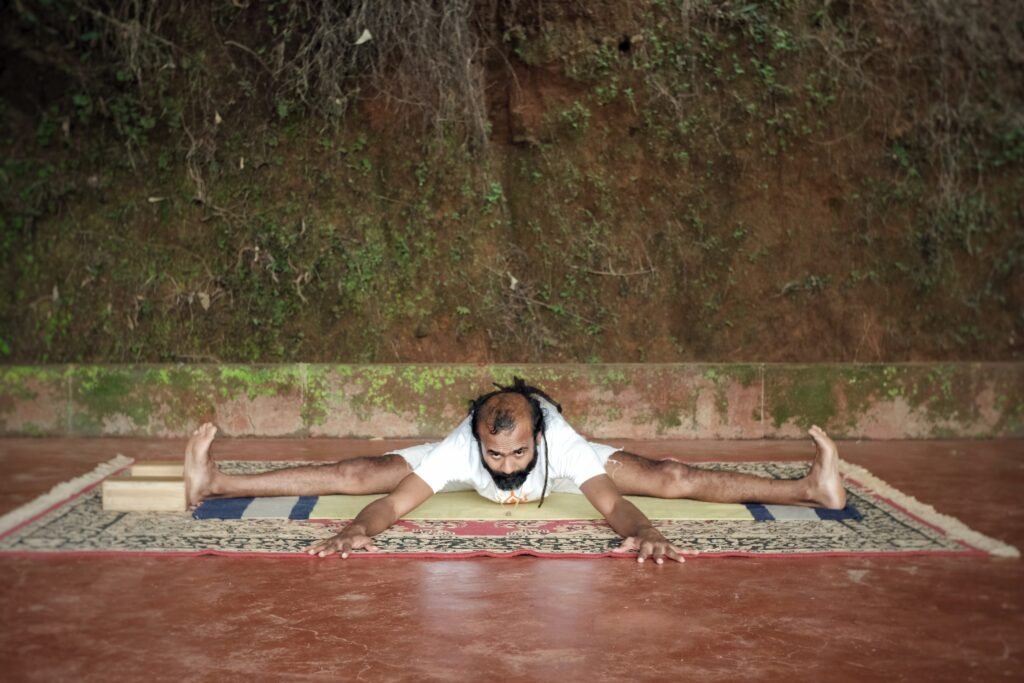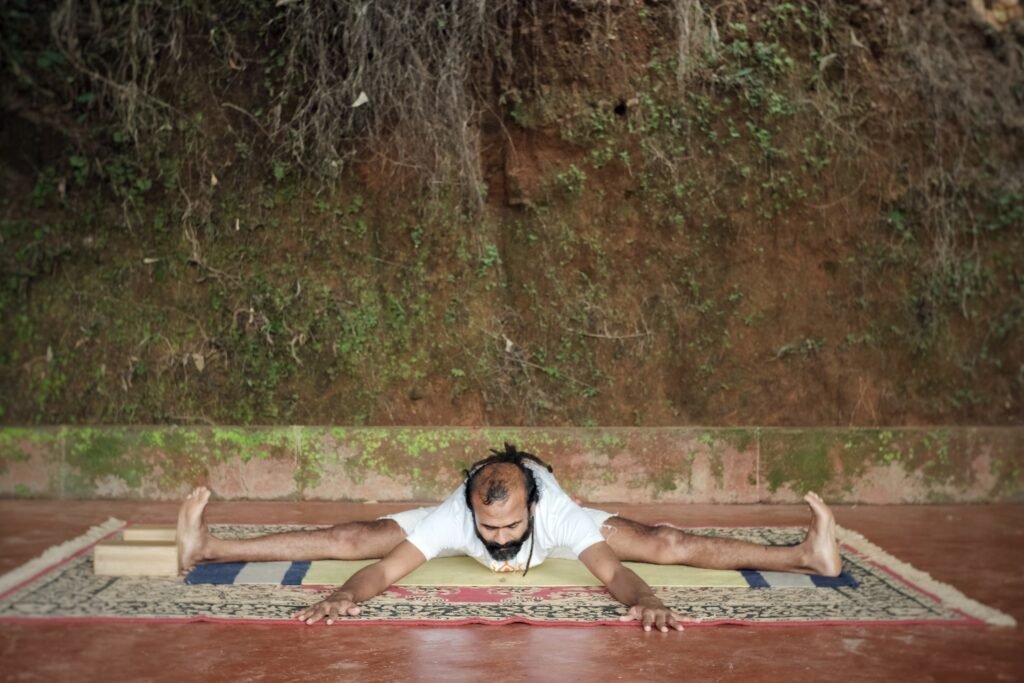
The term Seated Straddle Pose (Upavistha Konasana) comes from the Sanskrit words upavistha, which means sitting or seated, Kona, which means angle, and asana, which means position. The sit bones are grounded in this challenging intermediate pose, which gently bends the torso and hips forward. As the side bend with the hips in the external rotation has advantages, the seated side stretch pose (Parsva Upavistha Konasana) can also aid in opening the deeper groin and psoas muscles.
To counter the outer rotation of the hips, yoga instructors must remember that the intense stretch needs to be cooled down. The muscles must return to their original state by remaining in Seated Wind Release Pose (Upavistha Pawanmuktasana) or Cow Face Pose A (Gomukhasana A) for at least three minutes.
STEPS FOR SEATED STRADDLE POSE:
- Sit on the floor with the legs in front of you (Dandasana).
- Use a blanket, bolster, or block if an additional spinal lift is required.
- Exhale, then spread your legs widely. Press through your feet while extending your heels.
- Strike up the thigh muscles. Look up, expand your spine, and lift your chest.
- Exhale and thrust your pelvis forward. As you advance with your hands between your legs, maintain the length of your spine.
- Reach down to your feet through the crown of your head.
- Sink a little deeper with each exhalation.
- Stay for 30 to 60 seconds or longer if you feel comfortable. Inhale, let go of the hands, and rise gradually. Join the legs collectively.

Upavistha Konasana (Sitting Straddle Pose) Benefits:
Lengthens, Strengthens, and Stretches:
Upavistha Konasana, known as the seated straddle pose, stretches the hips, hamstrings, calves, shoulders, and arms. The pectineus muscle, which connects the femur and pubic bone, and the adductor muscles (inner thigh muscles), are both stretched in this position. It fortifies the knees, hips, quadriceps, and core.
In particular, the lumbar spine is lengthened, and over time, it also tones the spine. When taught with the appropriate cues and instructions, repeated practice of this pose can also aid in shedding excess fat from the thighs, buttocks, abdomen, chest, belly, and hips.
Flexibility, range of motion, and alignment and posture:
By extending the legs deeply, releasing the pelvic joints, and lengthening the spine, the muscles, and ligaments that support these functional areas become more flexible.
Flexibility lowers the possibility of injuries and avoids sore muscles.
For some students, transitioning from Upavistha Konasana to Merudandasana (Spinal Column Pose) or vice versa can be simple because a flexible and toned body improves body posture.
Consciousness and Concentration:
Finding the sit bones is the first step in becoming aware of this pose.
The practitioner cannot bend forward while sitting on the sides of their buttocks. Moreover, pay attention to your feet and knees (keeping them active and facing upwards).
Equally engaging the hips and shoulders, keeping the spine active and lifted from the base, lengthening the lower back and core muscles before bending forward, learning to carefully tilt the pelvis in the forward bend action, keeping the core and abdomen active to support the back as it stretches deeper forward, and finally maintaining long, active arms to complete the forward bend stretch. Together, these contribute to maximizing the pose’s benefits and preparing the body for more difficult poses that call for greater awareness, such as the Tortoise Pose (Kurmasana) and the Seated Straddle Pose with Head and Hands (Upavistha Konasana Sirsa Hasta), to name a few.
Energising, relieving stress, and unwinding:
Internal organ function is significantly impacted by all forward bend poses, especially those done while seated. The spine, chest, and abdomen are all engaged in the Seated Straddle Pose (Upavistha Konasana), which significantly impacts the flow of energy (prana).
The action of the forward bend ensures the outward flow of unwanted energy, or Apana vayu while keeping all of the other Pancha Vayus active in the process, or vayu. As you come out of the pose, your system receives a fresh energy supply.
The body-mind coordination is improved with this process of energy (prana) flowing inward and outward, sending the brain the proper signals to stay calm and alert.
This process guarantees the elimination of unwelcome stress or emotions from the body.
Organs, circulation, and systems stimulated:
Upavistha Konasana stimulates the reproductive and digestive systems. The deep pelvic and groin stretch increases blood supply to the reproductive organs.
The core strength and forward bend stimulate the digestive system by massaging the abdominal muscles.
As soon as the pose is released, the internal organs are soothed by the partial resumption of blood flow in the hip and pelvic region.
Therapeutic, Healing, and Ailments:
Although Seated Straddle Pose is difficult on the lower back, hips, pelvis, and hip flexors, it can help with sciatica problems (provided the condition is not severe) or the early stages of arthritis when performed in Seated Straddle Pose Bolsters (Upavistha Konasana Bolsters).
This pose can treat infertility, lack of sexual arousal, and sexual impotence.
It effectively controls the menstrual flow, makes periods painless, and eases Polycystic Ovary Syndrome (PCOS), a hormonal condition that affects women. This pose can help with simple digestive issues like constipation and a lack of appetite.
Balance and Emotions:
Negative emotions, fear, and stress build up in the hips due to activating the first three chakras. The hips and legs’ tense muscles are relieved by performing this pose.
Additionally, regulating the hormones in the body, which have a direct impact on mood changes and emotions, this pose aids in boosting self-confidence in the individual.
The seated straddle pose bolster (Upavistha Konasana Bolster) is an alternative restorative variation for patients with trauma and anxiety.
Others:
Teenagers, women, gymnasts, ice skaters, and athletes can all perform the seated straddle pose (Upavistha Konasana).
Contraindications for Upavistha Konasana
Surgery and Injury:
People with injured ankles, shoulders, hips, rib cages, pelvises, or knees should avoid the seated straddle pose (Upavistha Konasana). People who recently had hip, spine, or knee surgery should also be discouraged from performing this pose.
Improper Body-breath connections:
Seated Straddle Pose requires good breath control (Upavistha Konasana).
In order to bend forward, take a deep breath in and exhale smoothly. This will lengthen the torso from the hips.
Once the student is in the pose, the yoga instructor directs them to stretch forward and deepen with each exhalation gradually.
Students who don’t understand the connection between breathing and movement may jerk and try to bend forward, which can be harmful.
Because the muscles in the pelvis are delicate, it is important to avoid overextending them in this pose without being aware of how your breath and body are moving.
Consequently, the practice should be done gradually as the students’ hips and lower backs change in tiny ways.
Physical Strength and Weak Body:
This pose shouldn’t be encouraged for students with weak knees, ankles, or backs; it takes basic strength and stability. Those who have high blood pressure should also stay away from this. Students with painful sacroiliac joints or extremely tight hamstrings should avoid this pose. The sacroiliac joints may become compressed due to the deep hip opening.
Others:
To make the practice safe and effective for pregnant women and senior citizens, consider Seated Straddle Pose Bolsters (Upavistha Konasana Bolsters) or Seated Straddle Pose Head Blocks (Upavistha Konasana Hasta Block).
